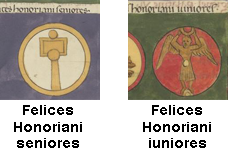
This page created 12 April 2014, and last modified: 30 July 2015 (Maier reference numbers added)

The Felices Honoriani seniores is is listed (15.14 in Ingo Maier's numbering scheme) as one of the units under the command of the Magister Militum per Orientem. Its shield pattern (13#3) as shown in various manuscripts, under the matching label (13.c) Felices Honoriani seniores, is as below:

The form of this shield pattern is unique in the Notitia. Given the depiction of unit standards as shield patterns elsewhere in the Notitia (e.g. that of the Herculiani iuniores, 9.19), I am tempted to see in this a debased image of an auxiliary unit's signum (standard), with the two discs being undersized phalarae (medallions). Although there well may be other explanations that could be plausibly advanced, my conclusion is buttressed in this case because the shield pattern for the Felices Honoriani iuniores (9.37), under the command of the first Master of the Soldiers in the Imperial Presence, also depicts a standard (in this case, of the Victory-type). One may compare the two shield patterns, as shown below from the patterns shown in the Paris manuscript...

...with standards as shown on the Arch of Constantine, dated to AD 312-315 as a whole, but here re-using material dating from 2nd century:

Note that while the unit is clearly meant to be a unit of auxilia palatina, it is not actually listed or otherwise described as such; indeed, it is listed under the heading (15.2) "Vexillationes comitatenses". It would appear that a heading saying either "Auxilia palatina", "Auxilia palatina II", or "Auxilia palatina duo" has been omitted from the list in between entries 15.12 and 15.13. This may have something to do with the fact that entry 15.12 is unusually long: Cuneus equitum secundorum clibanariorum Palmirenorum.
The name Honoriani refers to the emperor Honorius, who succeeded his father Theodosius I in 395, around the time the Notitia was first compiled (he had however, been declared co-Augustus two year earlier, at the age of 7). Felices means "fortunate" or "lucky", and was a common moniker for Roman units; over twenty units in the Notitia incorporate it into their name (it also carried a less common meaning of "fruitful, fertile").

Return to the Notitia alphabetical unit list page.
Return to my Notitia index page.